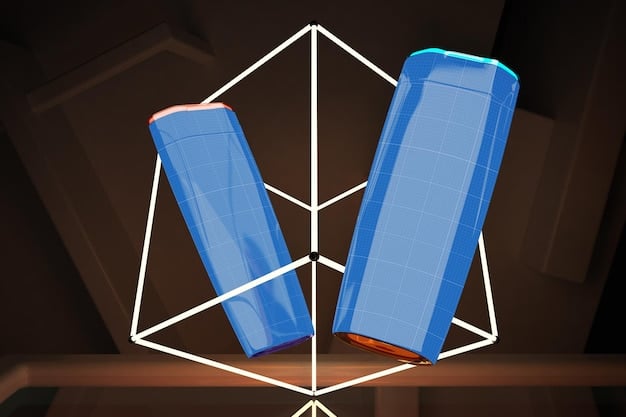Will Solid-State Batteries Replace Lithium-Ion in Smartphones by 2026?

Solid-state batteries, offering improved safety and energy density, are being developed as a potential replacement for lithium-ion batteries in smartphones by 2026, but challenges in cost, scalability, and performance parity remain to be overcome.
The future of smartphone power could look very different if will solid-state batteries replace lithium-ion in smartphones by 2026?. The industry is racing to develop better batteries–more efficient, safer, and longer-lasting.
The Promise of Solid-State Batteries
Solid-state batteries represent a significant leap forward in battery technology. Unlike traditional lithium-ion batteries that use a liquid electrolyte, solid-state batteries employ a solid electrolyte. This seemingly simple change has profound implications for battery performance, safety, and longevity.
These batteries are considered potentially disruptive technology due to their high energy density and resistance to overheating versus liquid Li-ion batteries.

Advantages of Solid-State Batteries
Solid-state batteries offer several key advantages over their lithium-ion counterparts. These include:
- Enhanced Safety: The solid electrolyte is non-flammable, significantly reducing the risk of fire or explosion.
- Higher Energy Density: Solid-state batteries can store more energy in a smaller volume, leading to longer-lasting smartphones.
- Faster Charging: They have the potential for much faster charging times, minimizing downtime.
- Improved Longevity: Solid-state batteries are expected to have a longer lifespan, maintaining their performance over more charge cycles.
Ultimately, these improvements mean that solid-state batteries offer a more reliable and streamlined end-user experience.
In summary, solid-state batteries offer a whole host of benefits from longer lifespans, safer batteries with more efficient charging times, and more energy in a smaller volume. They are a marked step up from their traditional lithium-ion counterparts.
The Current State of Smartphone Batteries
Lithium-ion batteries have become the pervasive technology powering virtually every smartphone. Despite their widespread use, however, they are not without their limitations.
While lithium-ion batteries have dominated the market, they are a mature technology, and further improvements are becoming increasingly difficult to achieve. This paves the way for new technologies like solid-state batteries to disrupt the industry.
Limitations of Lithium-Ion Batteries
The well-documented problems of lithium-ion batteries include:
- Safety Concerns: The volatile liquid electrolyte poses a fire hazard, as demonstrated by incidents of exploding smartphones.
- Limited Energy Density: Lithium-ion batteries are approaching their theoretical energy density limit, restricting further improvements in battery life.
- Slow Charging Speeds: Charging times remain a bottleneck, especially for larger batteries.
- Environmental Concerns: The mining of lithium and other battery materials raises environmental and ethical issues.
Although improvements are still being made, solid state batteries offer improvements over the more established tech.
While effective, lithium-ion batteries present challenges in safety, energy density, charging, and environmental considerations that open the door for innovation from solid-state batteries.
The Race to Develop Solid-State Batteries
The potential of solid-state batteries has ignited a global race among battery manufacturers. Companies around the world are investing heavily in research and development to bring this technology to mass production.
The next generation of batteries could revolutionize the smartphone market as companies vie to be the first to market with a commercially viable solid-state battery.

Key Players in Solid-State Battery Development
Some notable players in the solid-state battery space include:
- Samsung: The South Korean giant has showcased solid-state battery prototypes and is actively working on scaling up production.
- LG Energy Solution: Another major player, LG is investing heavily in solid-state battery technology for various applications, including smartphones.
- Toyota: While primarily focused on automotive applications, Toyota’s advancements in solid-state batteries could trickle down to consumer electronics.
- QuantumScape: This US-based company is developing solid-state batteries with a focus on high energy density and fast charging.
The innovations coming from these major players have the potential to boost innovation in the solid-state battery space.
Global competition is intense among the leading companies pushing to develop commercially viable solid-state batteries and lead the next evolution of smartphone power.
Challenges and Obstacles
Despite the great promise of solid-state batteries, significant hurdles remain before they can become a mainstream replacement for lithium-ion batteries in smartphones.
Scaling up production is expensive and technically demanding, a factor that is limiting the widespread production of solid-state batteries.
Key Challenges Facing Solid-State Battery Adoption
Some of the key challenges include:
- Cost: The materials and manufacturing processes for solid-state batteries are currently more expensive than those for lithium-ion batteries.
- Scalability: Mass production of solid-state batteries with consistent performance and reliability remains a challenge.
- Performance: Achieving the same or better energy density, cycle life, and charging speeds as lithium-ion batteries is crucial for widespread adoption.
- Infrastructure: New manufacturing facilities and equipment are needed to produce solid-state batteries, requiring significant investment.
However, with time, these challenges should become easier to surmount, leading to improvements in the production and performance of solid-state batteries.
High costs, scalability issues, performance targets and infrastructure needs continue to stand in the way of solid-state batteries becoming the dominant power source for smartphones.
Will 2026 Be the Year of Solid-State Batteries?
Given the current state of development and the remaining challenges, it’s difficult to definitively say whether solid-state batteries will completely replace lithium-ion batteries in smartphones by 2026.
Although the industry is working hard to make it possible, whether solid-state batteries completely replace lithium-ion batteries in smartphones by 2026 largely depends on whether key challenges are overcome.
Factors Influencing the Timeline
Several factors will influence the timeline for solid-state battery adoption:
- Technological Breakthroughs: Unexpected advancements in materials science or manufacturing processes could accelerate development, and improve efficiency.
- Investment and Funding: continued investment from industry and governments will spur further innovation.
- Market Demand: Consumer enthusiasm for longer battery life and improved safety could drive demand, prompting faster adoption.
- Competition: The intensity of competition among battery manufacturers will incentivize faster innovation and production scaling.
As competition ramps up, there is increasing pressure to accelerate breakthroughs.
Technological progress, investments and competition will be key drivers in determining if 2026 will be the year solid-state batteries replace lithium-ion batteries in smartphones.
The Future Landscape of Smartphone Batteries
Even if solid-state batteries don’t completely replace lithium-ion batteries by 2026, they are likely to play an increasingly important role in the smartphone market.
In the years to come, solid-state batteries have the potential to increasingly infiltrate into the smartphone industry, perhaps offering solutions for certain models.
Potential Scenarios for the Future
Some potential scenarios include:
- Hybrid Batteries: A combination of solid-state and lithium-ion technologies could offer a balance of performance, cost, and safety.
- Niche Applications: Solid-state batteries could initially be used in high-end smartphones or devices where safety and energy density are critical.
- Gradual Transition: The transition to solid-state batteries could be a gradual process, with lithium-ion batteries remaining dominant for several years.
One likely possibility is that lithium-ion batteries will still be prevalent for the majority of models while solid-state batteries appear only in high-end models.
Instead of a complete takeover, hybrid models might be more likely in the years ahead: the change to solid-state may be gradual, or the battery could find uses in niche or specialty situations.
| Key Point | Brief Description |
|---|---|
| 🔋 Safety | Solid-state batteries use non-flammable electrolytes, decreasing risk of fire. |
| ⚡ Energy Density | Solid-state batteries hold more energy, allowing longer smartphone usage. |
| ⏱️ Charging Speed | Solid-state batteries can charge rapidly, reducing downtime. |
| 💰 Cost | Manufacturing solid-state batteries remains expensive compared to lithium-ion. |
FAQ
▼
Solid-state batteries use a solid electrolyte instead of the liquid or polymer gel found in lithium-ion batteries. This allows for higher energy density and improved safety due to the non-flammable nature of the solid electrolyte.
▼
Their solid electrolyte is non-flammable and more stable at high temperatures, reducing the risk of thermal runaway (overheating leading to fire or explosion) compared to the volatile liquid electrolytes in lithium-ion batteries.
▼
Key challenges include high manufacturing costs, difficulties in scaling production to meet market demand, and ensuring the batteries achieve performance parity with lithium-ion in terms of energy density and cycle life.
▼
Several major players are in the race, including Samsung, LG Energy Solution, Toyota, and QuantumScape, among others. Each company is pursuing different approaches to overcome the challenges and commercialize the technology.
▼
While solid-state batteries show enormous promise, lithium-ion batteries are still competitive thanks to innovations in manufacturing lithium-ion batters, so it’s still too soon to say, but it will ultimately depend on overcoming existing challenges and market conditions.
Conclusion
Whether will solid-state batteries replace lithium-ion in smartphones by 2026 remains to be seen. While challenges persist, the potential benefits of these batteries are undeniable. As research and development continue, we can expect to see solid-state batteries play an increasingly significant role in the future of smartphone power, even if a complete transition doesn’t occur within the next few years.





